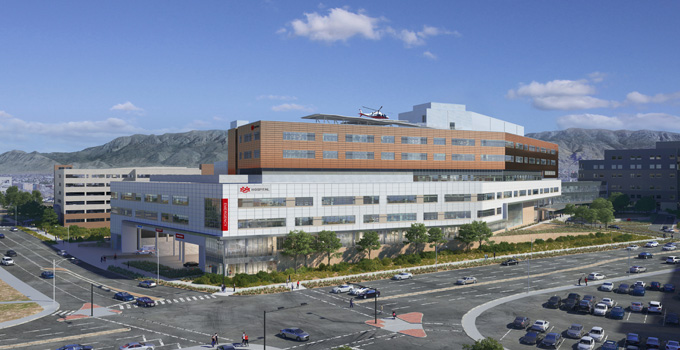On average, three helicopters race across the turquoise skies of Albuquerque and land at the University of New Mexico Hospital each day.
These helicopters transport patients with life-threatening injuries from across New Mexico, Arizona, and Colorado to the state’s only level-I trauma center.
This vital service will expand to a second helipad over the ninth floor of the burgeoning Critical Care Tower (CCT).
“The new helipad on the CCT will greatly improve patient outcomes because it will reduce time and increase access to our services,” said Robert Perry, director of Emergency Preparedness and the Dispatch Center at UNM Hospital.
The Barbara and Bill Richardson Pavilion (BBRP) has housed the hospital’s only helipad since 2007. This location receives more than 1,000 helicopter landings each year, transporting both pediatric and adult patients.
This helipad serves an indispensable role in saving lives, and adding a second helipad on UNM Hospital’s campus will allow more New Mexicans and patients across the southwest to receive the critical care they need.
The CCT helipad will have contemporary and dynamic additions that will speed up the process of arrivals and departures of every helicopter coming to UNM Hospital.
First, the helipad on the CCT will contain a small loft to allow a UNM Hospital security officer to safely survey the entire roof and visualize the path of the helicopters. Cameras will be placed nearby so that the dispatch team can provide more watchful eyes on the site.
Second, the CCT helipad will have more space to stockpile equipment and tools. “We’ve always had storage issues for equipment, like oxygen tanks and stretchers,” Perry said. “The new helipad on the CCT will have new storage locations up there for equipment and crews.”
Third, a second helipad on campus will alleviate the challenge of when multiple helicopters need to land simultaneously, a situation which Perry said does happen sometimes.
Two helipads available will open up the flow of air traffic and will avoid helicopters waiting to land. Likewise, each helipad will serve a different type of patient. The BBRP helipad will receive pediatric cases while the CCT helipad will accept adult cases.
Moreover, the strategic design of the CCT will also enable medical teams to transport patients from the helipad to the specific area of care that they require in less time.
“The CCT will stack several services on top of one another under the helipad,” Perry said. “An elevator will take patients from the helipad down to the emergency department, radiology, operating rooms, or the intensive care units. This new system is going to eliminate a lot of movement and time across the hospital.”
The new helipad will also have several innovative features, including: an automatic foam fire suppression system, snowmelt system, LED walkway floodlights, green perimeter safety lights, non-skid helipad deck and hallways, and room for a second CCT landing pad in the future.
Every day, patients travel by air to access many of New Mexico’s “only” services at UNM Hospital. The helipad on the roof of the CCT, with the potential to expand to another in the future, will ensure more people in need of those life-saving services will reach them faster and more efficiently.
To learn more about the hospital expansion, visit https://unmhealth.org/locations/tower.html.
